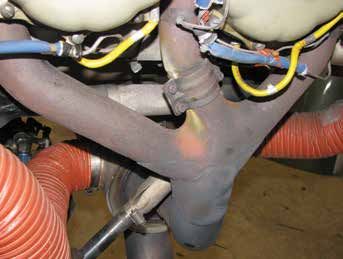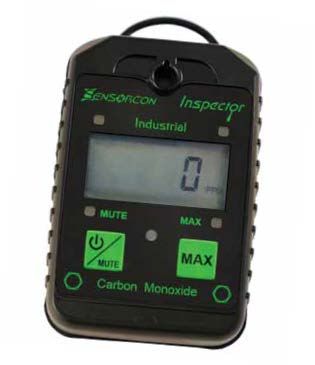Exhaust systems exist to provide a path for the byproducts of combustion and direct them away from an engine. In most any application, however, they’re often asked to do more, with heat extraction and spinning a turbocharger of particular interest to aircraft designers. In winter and at high altitudes, a healthy exhaust system can keep you warm. Year-round, a faulty one can kill you.
Properly managing all the heat and toxic exhaust gases an aircraft piston engine can generate means performing scheduled inspections and maintenance according to the manufacturer’s specifications. A well-maintained exhaust system helps ensure the aircraft continues to perform as it was designed. Poor maintenance, at a minimum, means some systems may not function as well as they should.
Characteristics
At least as far as piston engines are concerned, aircraft exhaust systems are considered part of the airframe, something the manufacturer designed specifically for the make and model. And there are a number of engineering considerations involved.
Examples include the routing of the exhaust, the size and shape of the tubing, the proper support brackets, and heat shields. There often needs to be a way to extract energy from the exhaust to provide the required heat output for the carburetor and cabin heat. The design must be light in weight and in the case of turbocharging must withstand high heat and pressure for extended periods without failing.
The design of the tailpipe must divert exhaust gas away from the aircraft and not interfere with the aerodynamics or disturb the airflow through the cowling. And it must conform to the engine manufacturer’s specifications. These are just a few of the hurdles to designing an exhaust system.
An associated design consideration aboard a typical piston single is the firewall between the engine compartment and the cabin. Holes, cracks and gaps in firewall seals can allow leaked exhaust gas containing carbon monoxide to enter the cabin even when the cabin heat is off or disconnected.
Maintenance, Inspection
The first order of business in the inspection process is to become familiar with the specific exhaust system and components so that the aircraft is maintained in the desired condition. As always, the place to start is the manufacturer’s maintenance and parts manuals. This is also true when considering an aftermarket exhaust system, including turbochargers, typically installed according to a supplemental type certificate (STC). Aftermarket exhaust and turbocharger providers like Power Flow and Tornado Alley Turbo offer documentation at least as good as the airframe manufacturer’s, including installation instructions, parts manuals and instructions for continued airworthiness.
A proper exhaust system inspection probably requires some disassembly, at minimum removing the external shrouds from carburetor and cabin heat exchangers in search of cracks, missing parts or distorted tubing. Pressure-checking the exhaust system or components such as heat exchangers with shop air and a soap/water solution can work miracles in discovering leaks.
Repairs
Aircraft exhaust systems are predominately constructed of stainless steel or, in some cases, an alloy called Inconel. Welding these components to make repairs rarely is effective or has a short useful life thanks to contamination from all the exhaust gases passing through. Field welding of the thin base material (0.025 to 0.049 inches) is especially problematic. The impediments from the exhaust gas—together with the high heat and thin base material—make it impossible to remove the contaminates so as to get a clean full-strength weld.
Another problem with field repairs involving welding is the metal exhaust components repeatedly have been subjected to high heat and vibration, likely becoming stressed and distorted, and requiring a jig or fixture duplicating the original installed position. As a result, when welding is accomplished, the finished product will fit exactly as the original would without twisting or binding.
Repair stations set up to repair or manufacture exhaust systems have a major investment in fixtures or jigs to ensure the finished product will fit like a glove and that the function and service life will meet or exceed original equipment standards.
Removing an exhaust system component for repair at a local welding shop can end up to be an expensive mistake without the expertise and appropriate fixtures or jig to rework the component. Without a jig or fixture to help position components, there’s no guarantee the repaired part will fit. Even if it does, it may last for only a short time before failing and exposing the cabin/pilot to hazardous carbon monoxide. And it’s probably illegal to perform any welding on a certified airplane’s exhaust without being the manufacturer or someone approved by the FAA to repair exhausts.
Yes, exhaust system repairs can be expensive. But repairing the system correctly is the only way to ensure safety and a normal service life.
Tips and Techniques
Getting the most service life out of an exhaust system while ensuring safe flight operations should be important to everyone in the aviation community. Learn the warning signs of a deficient exhaust system that you may discover on a preflight. These can include soot leaking where the exhaust mates with the cylinders, loose tailpipes, and cracked or perforated tubing. Correcting minor deficiencies as they occur will save you money and promote safety. Recognize the warning signs of carbon monoxide poisoning and purchase a CO detector or two and use them (see the sidebar on the opposite page for more on CO).
Presuming your engine has one, always cycle the carburetor heat control during your pre-takeoff checks. You’re doing this not only to verify the control itself is operational but also to verify its effect: There should be a slight reduction in rpm as the engine’s fuel mixture is enrichened by the warmer and less-dense air. If there isn’t, lean the mixture a bit to allow carb heat application to make it richer, then try again. If you still can’t verify the carburetor heat is working, get a mechanic to look at the system.
Enlightened use of the mixture control also can help with your exhaust system’s longevity, primarily if you have a turbocharger. Setting the mixture by using exhaust gas temperature (EGT) as your guide is a reliable way to lean the engine and conserve fuel in cruise. An engine with a modern turbocharger installation, meanwhile, likely will use turbine inlet temperature (TIT), the temperature of the exhaust gases entering the turbocharger, to determine where to put the mixture control. Temperatures at or near the maximum can have a significant effect on the service life of the exhaust system. Running a turbo at peak TIT temperatures isn’t good for the turbo and can result in reducing the life of other exhaust system components.
On the maintenance side of the house, perhaps most important is the fit of the parts. Forcing pipes to fit together, drawing up the exhaust flanges onto the cylinders by turning the nuts and installing clamps without preparing the base material can lead to early failure. Any time the exhaust system is removed from the cylinder head is a good time to inspect the mounting studs and nuts. Given the conditions under which they work, consider replacing appropriate hardware when removing the exhaust system for other maintenance.
Generous use of a high-temperature anti-seize compound on slip joints will allow the joints to move as intended during heating and cooling, reducing the opportunity for cracks and distortion. Dynamic balancing of the propeller can also extend the service life of the exhaust system, as well as other components.
Finally, keeping your exhaust system in good repair during the winter, especially, translates into more efficient cabin heating and greatly reduces the likelihood of a failure that might allow CO to become a factor.
Starting from the exhaust port on each cylinder, check for evidence of exhaust leaks such as light grey or dark soot around the flange area. Leakage in this area, if not corrected, can cause a cylinder to crack due to localized heat.
Look for signs of exhaust leaks around clamps and joints and bulges, pin holes or cracks in the tubing, especially around joints and the ends of the heat exchanger/muffler. Finally, check that the tailpipe (when cool) is not loose or moves only slightly when given a slight tug or push. During your pre-takeoff run-up, ensure that carburetor heat is operational.
Heat exchangers and mufflers often include baffles or flame cones designed to extract heat energy from the exhaust. Looking up the tailpipe with a strong light can reveal loose, distorted or missing baffles. To maximize heat transfer to the carburetor, those baffles need to be intact.


Carbon monoxide (CO) poisoning is a potentially fatal condition caused by inhalation of the odorless and colorless gas. Once inhaled, CO competes favorably with oxygen for binding with hemoglobin and thus interferes with the transportation of oxygen and carbon dioxide by the blood. Pilots and occupants of an aircraft have an increased susceptibility to this poisoning due to the reduced atmosphere density at flight altitudes. A relatively inexpensive carbon monoxide detector like the one pictured can warn pilots and passengers of such a situation.
The signs and symptoms of carbon monoxide poisoning may include: dull headache, weakness, dizziness, nausea or vomiting, shortness of breath, confusion, blurred vision and finally loss of consciousness and death. The concentration of carbon monoxide you or your passengers are exposed to will determine the severity of the symptoms.
It is understood that disabling fresh air vents with duct tape in the dead of winter would seem to be prudent. However, consider that these very vents could in fact save your life by providing access to fresh air. In cases of suspected carbon monoxide poisoning, strong consideration should be given to closing the heat valve, discontinuing your intended flight and landing at a nearby suitable airport to seek medical attention if necessary.
PERCENT CO IN BLOOD | TYPICAL SYMPTOMS |
<10 | NONE |
10-20 | SLIGHT HEADACHE |
21-30 | HEADACHE, SLIGHT INCREASE IN RESPIRATION, DROWSINESS |
31-40 | HEADACHE, IMPAIRED JUDGMENT, SHORTNESS OF BREATH, INCREASING DROWSINESS, BLURRED VISION |
41-50 | POUNDING HEADACHE, CONFUSION, MARKED SHORTNESS OF BREATH, MARKED DROWSINESS, INCREASING BLURRED VISION |
>51 | UNCONSCIOUSNESS, EVENTUAL DEATH IF CO SOURCE IS NOT DISABLED |
- Baffle, flame cones and other system components need to be in good working order for maximum heat transfer from the exhaust.
- The heat muff at right looks brand-new, and when mounted with an appropriate shroud can provide carburetor and cabin heat.
- Inspect the cabin heat system ducting for continuity, blockages or leaks, and to ensure any insulation is actually insulating.
- Never block or tape over fresh-air vents in winter, no matter how tempting. You may need that fresh air to recover from CO poisoning.


Mike Berry is a 17,000-hour airline transport pilot, is type rated in the B727 and B757, and holds an A&P ticket with inspection authorization.




